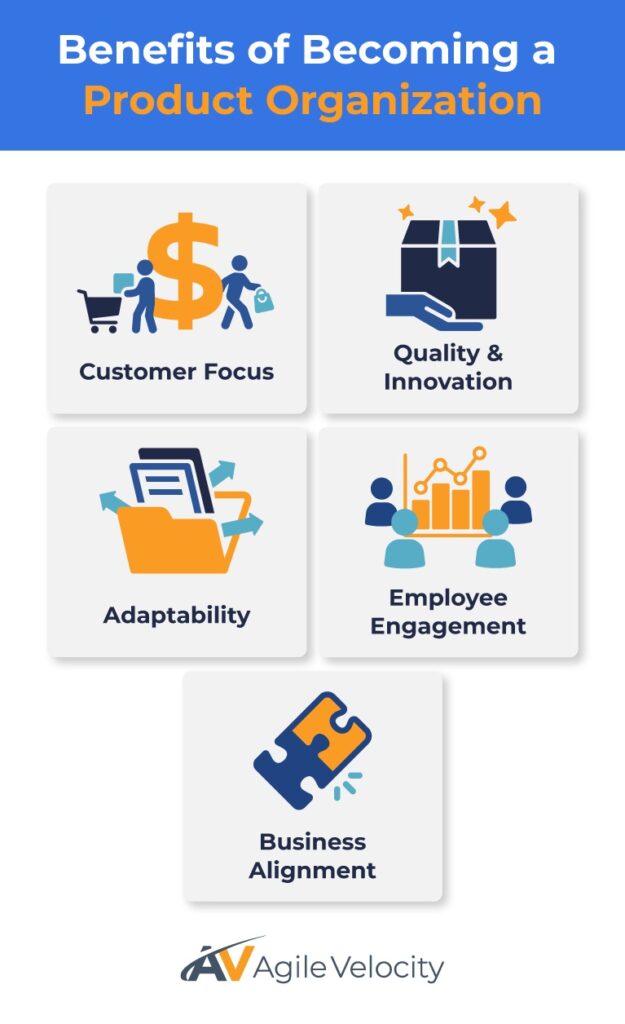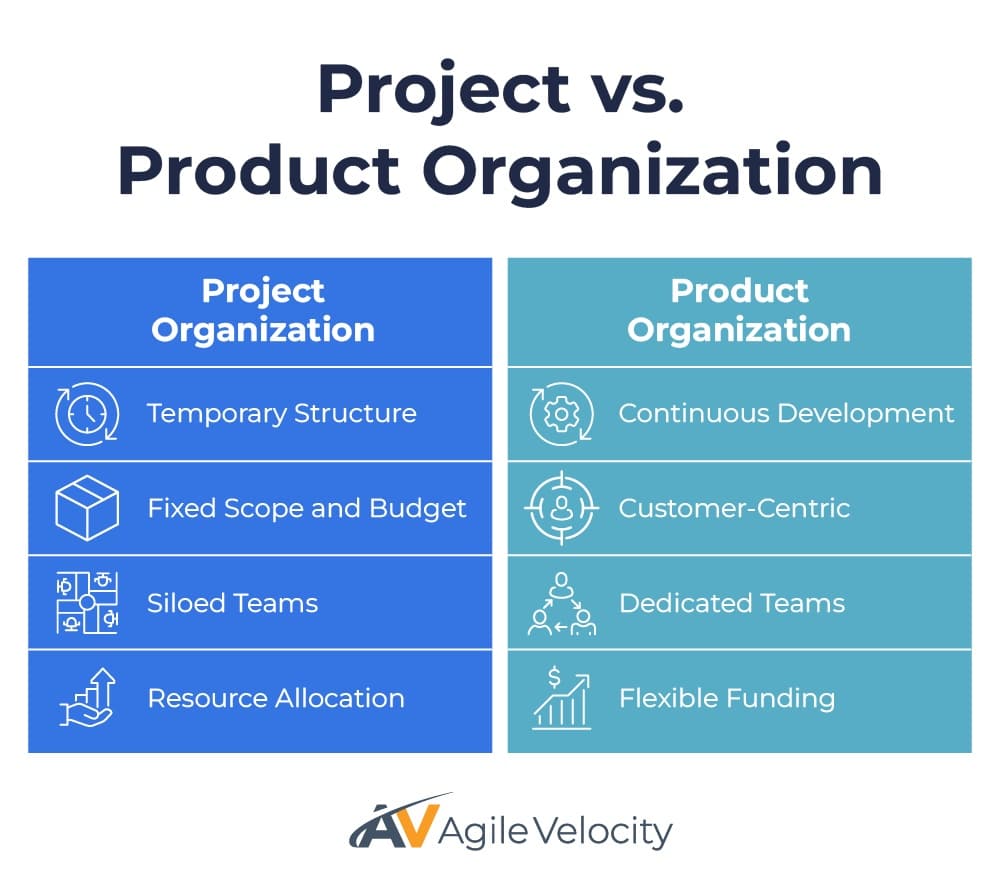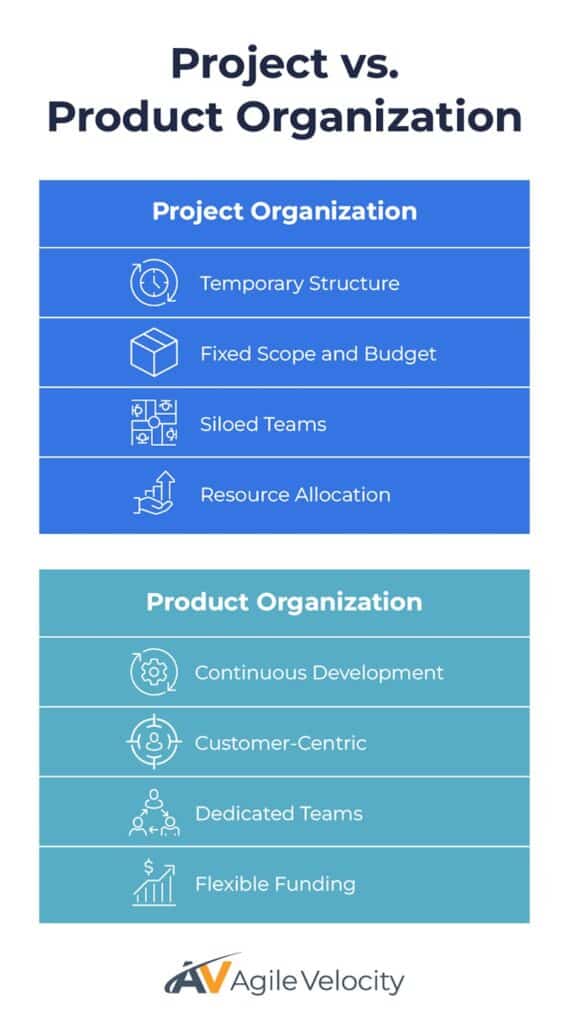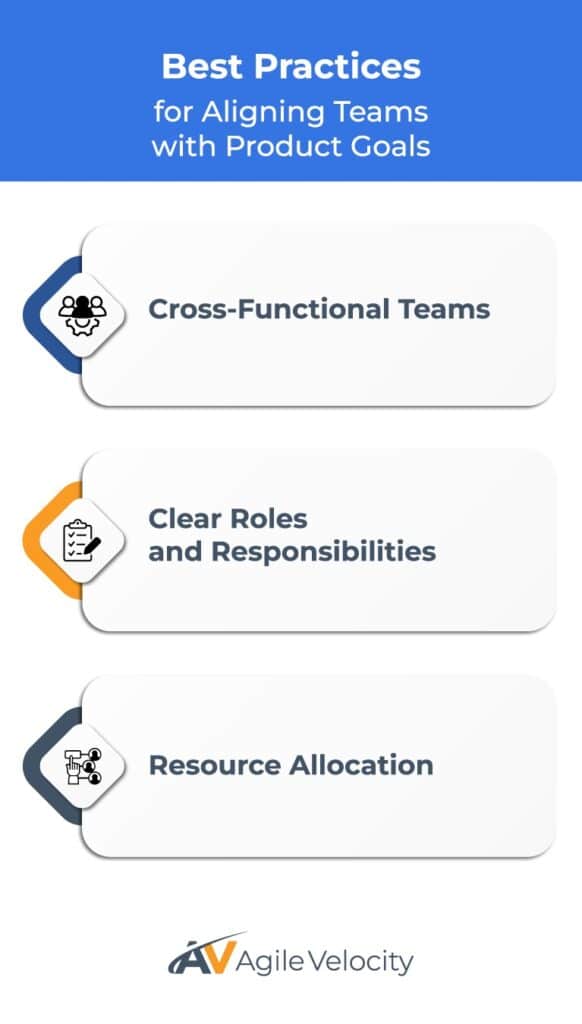In today’s rapidly evolving business landscape, organizations are constantly seeking ways to deliver value more efficiently and stay ahead of the competition. One significant shift that’s gaining momentum is the move from traditional project management to a product-oriented delivery approach. This transition is not just a change in terminology but a fundamental shift in how organizations think about their Agile Transformation.
Embracing a product organization means focusing on customer needs, fostering adaptability, and aligning closely with business outcomes. It’s about creating products that not only meet market demands but also drive strategic differentiation.
In this article, we’ll explore the benefits of making this shift in your Agile Transformation outcomes, understand the differences between project and product organizations, and provide actionable strategies to guide your transition.
Product-Oriented Delivery in Agile Transformation
The concept of product-oriented delivery revolves around centering your organization’s processes and efforts on the products you deliver, rather than on discrete projects. This approach prioritizes continuous value creation and customer satisfaction over the traditional project constraints of scope, time, and budget, which are common in an Agile Transformation outcomes context.
– Jeff Sutherland
From Project to Product Thinking
Traditional project management often involves temporary endeavors with specific start and end dates, focusing on delivering predefined outputs. While this method has its merits, it can sometimes lead to siloed teams, misaligned objectives, and a disconnect from the evolving needs of customers.
Shifting to product thinking encourages a long-term view, where teams are dedicated to the ongoing development and improvement of a product. This mindset fosters a deeper understanding of customer needs, promotes agility, and drives innovation. By maintaining a continuous focus on the product lifecycle, organizations can better anticipate market trends and adapt proactively rather than reactively.
The Importance of Customer Focus and Business Alignment
In a product organization, the primary goal is to continuously deliver value to customers. By focusing on customer experience and feedback, organizations can adapt quickly to market changes and emerging trends. This alignment with customer needs not only enhances satisfaction but also ensures the product remains relevant and competitive.
Moreover, aligning product development with business objectives ensures that every effort contributes to strategic goals. This synergy between product teams and business outcomes leads to more efficient resource utilization and better overall performance. It also facilitates clearer communication across departments, ensuring everyone is working towards a unified vision.
Benefits of Shifting to a Product-Oriented Delivery Organization
Transitioning to a product-oriented delivery organization offers numerous advantages that can significantly enhance your organization’s agility and effectiveness.


Improved Focus on Customer Experience and Strategic Differentiation
By centering efforts on products, teams develop a deeper understanding of customer expectations and pain points. This customer-centric approach leads to products that offer better experiences and meet real needs, setting your company apart from competitors. Additionally, it allows for the creation of unique features and offerings that can serve as key differentiators in the market.
Enhanced Quality and Faster Innovation Cycles
Product-focused teams are often more invested in the quality and success of the product. This commitment leads to higher-quality outputs and fosters an environment where innovation thrives. Continuous feedback and iterative development enable faster innovation cycles, keeping the product fresh and competitive. Furthermore, the ability to quickly iterate based on user feedback ensures the product evolves in line with user expectations.
Increased Adaptability to Evolving Requirements
In a dynamic market, requirements can change rapidly. Product organizations are better positioned to adapt to these changes due to their flexible structures and Agile Transformation outcomes. This adaptability ensures the product remains aligned with market demands and customer expectations. It also reduces the time and resources wasted on features that no longer add value.
Higher Employee Engagement and Collective Ownership
When teams are dedicated to specific products, they develop a sense of ownership and pride in their work. This collective ownership boosts morale and engagement, leading to increased productivity and job satisfaction. Employees are more motivated when they see the direct impact of their work on the product’s success and the satisfaction it brings to customers.
Better Alignment with Business Outcomes
By adopting a product-centric approach, organizations align their efforts with overarching business goals. This alignment ensures all teams are working towards common objectives, improving coordination and maximizing the impact of their work on the organization’s success. It also facilitates better decision-making, as priorities are clearly tied to business outcomes rather than arbitrary project goals.
Understanding Project vs. Product Organization in Agile Transformation
To successfully transition, it’s essential to understand the fundamental differences between project and product organizations within the context of Agile Transformation management.


Characteristics of a Project Organization
- Temporary Structure: Projects are temporary endeavors with defined start and end points.
- Fixed Scope and Budget: Focus is on delivering specific outputs within predetermined constraints.
- Siloed Teams: Teams are often assembled for the project duration and disbanded afterward, leading to knowledge loss.
- Resource Allocation: Resources are allocated based on project needs, which can lead to competition and inefficiencies.
Features of a Product Organization
- Continuous Development: Emphasis on ongoing improvement and evolution of the product.
- Customer-Centric Approach: Prioritizes customer needs and feedback throughout the development process.
- Dedicated Teams: Teams remain with the product long-term, promoting expertise and consistency.
- Flexible Funding: Funding is allocated based on product value and potential, supporting strategic initiatives.
Differences in Funding and Resource Allocation Strategies
In a project organization, funding is tied to specific projects, which may limit flexibility and responsiveness. Conversely, product organizations allocate funds based on product strategies and value propositions, allowing for more adaptable and strategic resource utilization. This approach enables organizations to respond more effectively to changes in the market and prioritize investments that offer the highest potential return.
Impact on Organizational Culture and Team Dynamics
Shifting to a product organization can transform the company culture. It encourages collaboration, innovation, and a shared vision. Teams become more cohesive, communication improves, and there’s a stronger alignment with overall business objectives. This cultural shift can lead to a more positive and productive work environment, where employees feel more connected to the company’s mission and goals.
Build High-Performing Teams
How to Transition from Project to Product Organization
Transitioning is a significant undertaking that requires careful planning and execution. Here are some helpful strategies to guide your journey.
Initial Assessment of Current Organizational Structure and Capabilities
Begin by evaluating your current state. Identify existing processes, team structures, and cultural factors that may impact the transition. Understanding your starting point is crucial for tailoring your transformation strategy. Conducting a thorough assessment helps in recognizing strengths, weaknesses, and areas that require change or enhancement.
Setting Clear Objectives and Business Outcomes for the Transformation
Define what success looks like for your organization. Establish clear, measurable objectives aligned with business outcomes. This clarity will guide decision-making and keep teams focused on the desired goals. Objectives might include improved customer satisfaction scores, faster time-to-market for new features, or increased employee engagement.
Strategies for Initiating the Transformation Journey
- Leadership Alignment: Ensure senior leadership understands and supports the shift.
- Communication Plan: Develop a plan to communicate the vision, benefits, and changes to all stakeholders.
- Pilot Programs: Start with a pilot product team to test and refine the approach before scaling.
Implementing these strategies helps in building a strong foundation for the transformation, fostering buy-in across the organization, and mitigating risks associated with change.
Strategies for Implementing Product-Oriented Delivery Approaches
Once you have initiated the transformation journey, the next step is helping your organization adopt the product-oriented delivery. This approach requires deliberate strategies and best practices.
Best Practices for Aligning Teams and Resources with Product Goals
In the evolving journey towards a product-oriented organization, effectively aligning teams and resources with product goals is crucial. This section provides the best practices for ensuring seamless coordination and resource optimization, which are essential to fostering a collaborative environment that supports strategic objectives and sustains long-term success. By adopting these approaches, organizations can enhance agility, boost innovation, and maintain a competitive edge in the marketplace.


- Cross-Functional Teams: Build teams with diverse skills that can handle all aspects of product development.
- Clear Roles and Responsibilities: Define roles to avoid confusion and overlap.
- Resource Allocation: Align resources with product priorities to ensure focus and efficiency.
Implementing these best practices helps in creating a cohesive and effective team structure can drive product success.
Techniques for Maintaining Focus on Customer Needs
- Regular Customer Feedback: Engage with customers frequently to gather insights.
- Customer-Centric Metrics: Use metrics that reflect customer satisfaction and value delivery.
- Empathy Mapping: Understand the customer’s perspective to drive product decisions.
These techniques ensure the product remains aligned with customer expectations and delivers true value.
Monitoring and Evaluating the Effectiveness of Product-Oriented Delivery Strategies
- Key Performance Indicators (KPIs): Establish KPIs that align with product goals.
- Regular Reviews: Schedule periodic reviews to assess progress and make necessary adjustments.
- Adaptation: Be willing to pivot strategies based on data and feedback.
Monitoring and evaluating strategies ensures the organization can continuously refine its approach and achieve optimal results.
Tips for Managing Change and Addressing Resistance
Foster an open culture where feedback is encouraged and concerns are openly discussed to overcome reluctance to change established norms.
- Engage Employees: Involve teams in the planning process to gain buy-in and reduce resistance.
- Provide Training: Offer education and resources to help teams adapt to new roles and processes.
- Celebrate Milestones: Recognize and celebrate progress to maintain momentum and enthusiasm.
Addressing resistance proactively ensures a smoother transition and helps in building a supportive environment where employees feel valued and empowered.
Overcoming Challenges Encountered During the Transformation
Be prepared to address common challenges such as:
- Process Misalignment: Adjust existing processes to fit the new model, ensuring they support product-centered work.
- Resource Constraints: Reevaluate resource allocation to align with product priorities.
- Skill Gaps: Identify areas where team members need additional training and provide opportunities for skill development to ensure they can thrive in the new structure.
- Consistency in Vision: Maintain a consistent vision across all levels of the organization to ensure everyone understands and aligns with the transformation goals.
Successfully navigating these challenges requires flexibility, open communication, and a commitment to continuous improvement throughout the transformation process.
Enhance Organizational Agility and Delivery Efficiency with A Continuous Improvement Software Solution
Continuous improvement is at the heart of organizational agility. Path to Agility® Navigator is a tool designed to assist organizations in their Agile Transformation endeavors and supports continuous improvement by offering insights that drive efficiency and adaptability. It offers various features to help organizations visualize their process, track progress, and outline actionable next steps. The tool’s comprehensive approach aids in achieving desired business outcomes by providing frameworks that adapt to any Agile framework being employed.
The software’s features support ongoing improvement by:
- Identifying Bottlenecks: Spotting areas where processes can be streamlined.
- Facilitating Communication: Enhancing collaboration across teams.
- Monitoring Progress: Keeping track of improvements over time.
Regular assessments and feedback loops enable your organization to adapt quickly to changes. By optimizing agility, you can respond effectively to market shifts and customer needs. This ongoing process of evaluation and adjustment ensures that the organization remains resilient and capable of thriving in a competitive environment.
These functionalities ensure that the organization can continuously refine its processes, leading to sustained efficiency and effectiveness in delivering value.
Ready to Become a Product Organization?

Transitioning from a project-focused to a product-oriented organization is a powerful way to enhance your Agile Transformation management. By focusing on customer needs, fostering adaptability, and aligning with business outcomes, your organization can achieve greater efficiency, innovation, and employee engagement.
Agile Velocity offers comprehensive services designed to support businesses transitioning to a product-oriented organization. They provide expert guidance on Agile Transformation, helping companies align teams, focus on customer needs, and improve delivery efficiency. By leveraging their tools such as the Path to Agility Navigator, businesses can enhance adaptability and strategic alignment, ensuring long-term success
Start your journey with Agile Velocity today and lead your organization to unparalleled success!



